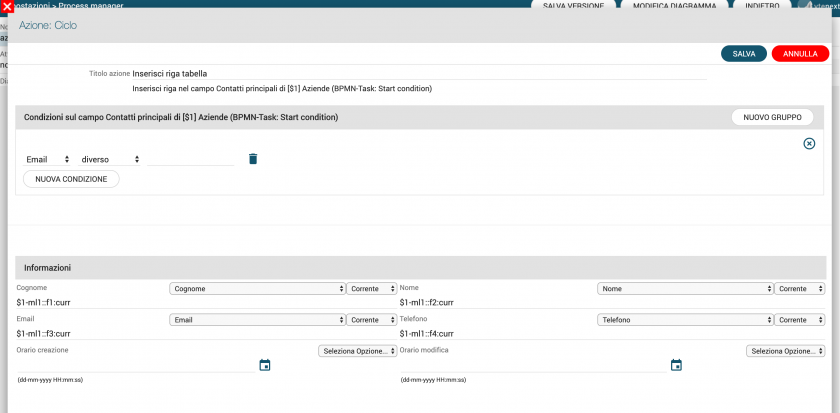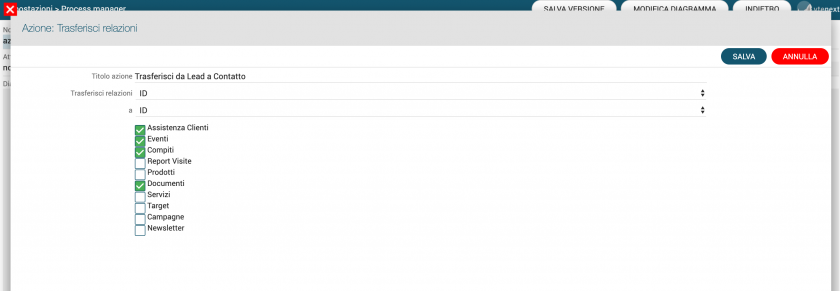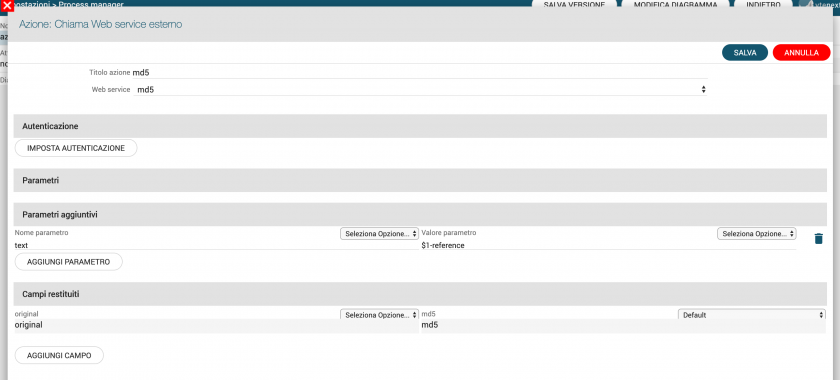BPMN Actions
Below the main BPMN actions:
1 - Create entity
2 - Update entity
3 - Delete entity
4 - Send notification
5 - Send email
6 - Send newsletter
7 - Create PDF
8 - Reset dynamic form
9 - Cycle
10 - Reset conditional fields
11 - Link entities
12 - Link static entities
13 - Transfer relations
14 - Insert table row
15 - Call external Web service
1 - Create entity:
This action allows to create record of system entities (standard or custom).
You can set a static or dynamic value for each one field (you can select values from involved process entities).

2 - Update entity:
This action allows to update an involved process entity or related ones.
You can set static or dynamic value for each one field (you can select values from involved process entities).

3 - Delete entity:
This action allow to delete a dynamic entity, an involved process entity.
This action is used in conversion processes cases, ex. conversion from lead to contact/account (deleting lead after the conversion) or in error cases, ex. re-planning of activities with creation of new entities and deleting the old ones.

4 - Send notification:
This action allow to send internal notification to the system users.
It's possible to set a specific text with static/dynamic data and relate entity. Besides, you can set the email parameters for the users that use email notification and not internal ones (you can change this settings into the user preference).

5 - Send email:
This action allows to send email with static/dynamic data.
It's possibile to set a static/dynamic sender email address (you can select email fields from involved process entities).
The same configuration is available for the email recipients (ex. record assigned user email , involved process partecipants, ecc).
Besides, you can relate the email to an involved process entity (or related ones). In this case, it will be possible to see a new message into the related list.
In the body message you can insert static/dynamic values and other general functions like current date/time, desired entity link (internal one for users or external one for portal customers).


7 - Create PDF:
This action allow to create a PDF document using an existing template.
It's possibile to select the PDF entity, desired template, the entity to relate document, language, assigned user and document folder.

8 - Reset dynamic form:
This action is based on ProcessHelper use and allows to clean its data off to re-use this one. So, it's used when the same Dynamic Form can be shown to the user many times. You need to clean its data to allow a new compilation.

9 - Cycle:
This action is based on Table field use. This one is not available if involved process entities (and related ones) haven't got this field into the module layout editor.
For each one table field row (and specific column conditions) is possible to send emails, create new entities, insert new rows (into the same field or other ones), delete rows, send notifications.




10 - Reset conditional fields:
This action is based on process conditional fields use.
Infact, it's possible to set conditional fields on the selected entity (involved into the process) or into the Dynamic form.
In the entity conditional fields case, these ones prevail over the general settings ones.
The last ones are disabled till the process end or an action task with "Reset conditional fields" action.

11 - Link entities:
This action allows to link 2 entities each other those have a N - N relation.
The 2 entities haven't got the relation field but a N relation.


12 - Link static entities:
This action allows to link a specific static entity to an involved process one.
It's useful when you have to link the same entity to many ones into the process, ex. link the same document (privacy policy, checklists, ecc.)


13 - Transfer relations:
This action allows to transfer/copy the related entities from a process entity to an other one.
In the 1 - N relation case, the record will be transferred, while with N - N relation the record will be copied.
This action is useful in process conversion cases where the start entity is converted to an other one, so all its related entities can be transferred/copied to the new one.
Ex. In a conversion process from lead to contact/account all lead related entities can be transferred/copied to the new contact/account. At the end it's possible to delete the lead without any lost.


14 - Insert table row:
This action is based on Table field use. This one is not available if involved process entities (and related ones) haven't got this field into the module layout editor.
This action allows to insert a new row into the specific table field.
The insert values can be statics/dynamics (you can select values from involved process entities).


15 - Call external Web service:
This action allows to call a REST external Web service.
It's possible to set call data into the Settings -> Business Process Manager -> External Web services.
You have to fill the endpoint, authentication parameters and returned fields. When it's done it's possible to use them into a process.
In the process configuration you can set dynamic parameters (name and value), so the web service call will have got all static data (specified into general settings) and dynamic ones (specified into the process).
Into the flow it's possible to check if the web service call has been suceessfullysuccessfully with the 3 static parameters it returns (success, response code and message code). In addition, the call will get the configured returned fields.
In the complex response case (object with many attributes) is possible to extract them till one escalation level (using return field name and attribute, ex. object.attribute).
It's not supported a response object list.


